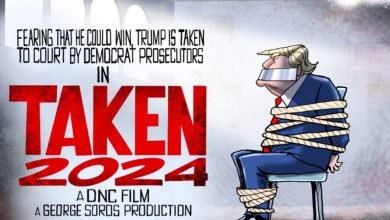Rebuttal of the ridiculous Roll Call commentary
Several weeks ago, the Roll Coll magazine published a ridiculous commentary by an anti-nuclear activist who seeks America’s unilateral disarmament and has launched yet another attack on the US nuclear deterrent – and more specifically, on the Navy’s ballistic missile submarine replacement program. He wants the Navy to cut the planned order from 12 to just 8 subs.
That commentary is a litany of blatant lies. There isn’t enough space here to refute all of these, but I will refute the most outrageous lies. (Dr Loren Thompson, who taught the subject of nuclear deterrence at Georgetown University for many years, has written his own rebuttal of the Roll Call piece.)
What’s wrong with that Roll Call piece? To start with, everything.
Because the author is an anti-nuclear activist seeking America’s nuclear disarmament, he wants to mislead the public into thinking that America’s nuclear deterrent can be safely reduced sharply and eventually scrapped. In order to mislead the public this way, he makes a number of utterly false claims.
For starters, he lies that “the Pentagon needs to resize its sub program based on the understanding that the U.S. can meet today’s security challenges with fewer nuclear weapons at less cost.” This is totally false.
In fact, the need for nuclear deterrence has not shrank at all since the end of the Cold War; if anything, that need has grown. During the Cold War, the US had to deter the Soviet Union, and on a lesser scale, China. Now it has to deter Russia and China – both of whom have large arsenals – as well as North Korea and Iran.
And while these countries are threats to many and protectors to nobody, the US has to provide a large nuclear umbrella not just for itself, but for over 30 of its allies – many of whom will “go nuclear” if the US continues to cut its own arsenal. 66% of South Koreans already want their country to do so.
Deterring Russia and China will require a nuclear arsenal of a size no smaller than the current one, and probably larger. Russia’s strategic nuclear triad consists of:
- 251 intercontinental bombers (64 Tu-95s, 16 Tu-160s, 171 Tu-22Ms), each capable of carrying 6 nuclear-tipped cruise missiles and one free-fall nuclear bomb;
- 75 SS-18 Satan heavy ICBMs (up to 10 warheads and 38 penetration aids each);
- 136 SS-19 Stilletto ICBMs (up to 6 warheads each);
- 171 SS-25 Sickle single-warhead ICBMs (though recent reports claim they can carry multiple warheads);
- 78 SS-27 Stalin single-warhead ICBMs;
- 18 RS-24 Yars ICBMs (4 warheads each);
- 13 ballistic missile subs capable of carrying 16 SLBMs and one (the Dmitry Donskoi) capable of carrying 20 SLBMs; each sub-launched ballistic missile, in turn, can carry 4, 10, or 12 warheads depending on the type (R-29RMU Sinyeva, RSM-56 Bulava, or R-29RMU2 Liner, respectively). Russia has ordered hundreds of these SLBMs.
In total, Russia’s ICBM fleet alone – to say nothing of its submarine or bomber fleet – can deliver 1,684 warheads to the CONUS. Russia’s bomber fleet could deliver over 1,700. Russia’s ballistic missile submarines could deliver between 1,500 and 2,000, depending on the types of missiles used.
A large, diverse nuclear arsenal – such as the one America has today – would be hard even for these thousands of warheads to destroy in a first strike. But a smaller one, such as a fleet of only eight SSBNs, only 4 of which would be at sea at any given moment, would be much easier to decapitate.
In recent years, while the US has been steadily cutting its arsenal unilaterally under New START, Russia has been growing its own, as it is allowed to do under the treaty. Also, the document contains no restrictions whatsoever on road- and rail-mobile ICBMs, treats every bomber as if it were carrying a single nuclear warhead, and doesn’t limit Russian ICBMs’ carriage capacity or throw-weight – which are huge loopholes that Russia is only too eager to exploit.
Russia is now developing a rail-mobile ICBM as well as replacements for Russia’s older ICBMs: a heavy ICBM called “Son of Satan” (designed to replace the SS-18 Satan) and a mid-weight ICBM called the Rubezh to replace the SS-19 and SS-25, while continuing RS-24 Yars production. Vladimir Putin announced last year that Moscow would order 400 new ICBMs for its strategic missile force. Meanwhile, the US has no plans to develop a road- or rail-mobile ICBM (although the USAF is considering the rail-mobile version), and development of the next-generation ICBM – the replacement for America’s aging Minuteman ICBMs – has been delayed by many years for political reasons.
Moscow is also developing and testing an IRBM, the Yars-M, in violation of the INF treaty – showing that arms control treaties signed with Russia are worthless pieces of paper.
On top of that, Russia has a huge tactical nuclear arsenal – much larger than America’s. Estimates of its size vary, but various sources say it numbers up to 4,000 warheads (all deliverable) – much more than America’s ca. 500. These 4,000 warheads can be delivered by a wide range of systems, from short-range ballistic missiles, to theater strike aircraft, to bombers, to torpedoes and surface ships, to cruise missiles, to artillery pieces, because they come in various forms: nuclear bombs, torpedo warheads, depth charges, artillery shells, cruise missile warheads, etc.
China, like Russia, has a large nuclear arsenal – far larger than the 240 warheads American arms control advocates claim. In fact, China has at least 1,600, and up to 3,000, nuclear warheads, most of them hidden in the 3,000 miles of tunnels it has built for its arsenal. The two estimates come from Gen. Viktor Yesin (Russian ICBM force CoS, ret.), and Professor Philip Karber, the DOD’s chief nuclear strategist during the Cold War. The existence and length of these tunnels is a confirmed fact.
To deliver its warheads, China has:
- 36 DF-5 heavy ICBMs (up to 10 warheads each);
- at least 30, and likely far more, DF-31 ICBMs (3-4 warheads each);
- at least one DF-41 heavy ICBM (10 warheads);
- 20 DF-4 IRBMs (3 warheads each);
- 20 DF-3 single-warhead MRBMs;
- 100 DF-21 MRBMs;
- 500 DH-10, CJ-10, and Hongniao cruise missiles;
- 440 nuclear-capable aircraft (Q-5, JH-7, H-6) each with at least one warhead attributed to them (the H-6K bomber variant can carry several nuclear- or conventional-tipped cruise missiles as well);
- 1 Xia class SSBN with 12 single-warhead JL-1 missiles; and
- 5 Jin class SSBNs with 12-24 four-warhead JL-2 missiles, with a sixth under construction to replace the Xia class boat.
On top of that, China has between 1,100 and 1,600, and possibly more, short-range ballistic missiles, though it isn’t known how many of these are armed with nuclear warheads.
China, of course, stubbornly refuses to reveal anything about its nuclear arsenal, while falsely claiming it pursues a “minimum nuclear deterrent” policy, even though it is evident to everyone except the willfully blind it has thousands, not mere hundreds, of warheads.
Over a year ago, this writer, based on very conservative estimates of China’s missile stocks and their warhead carriage capacity, estimated China had 1,274 nuclear warheads. This was calculated as follows:
I started with the 440 aircraft-deliverable nuclear bombs owned by the PLAAF and attributed to its H-6, Q-5, and JH-7 aircraft. Then, I added 10 warheads for each of China’s 36 DF-5 ICBMs, then, one DF-41 ICBM with 10 warheads, then, 40 DF-3 and DF-4 MRBMs, then 100 DF-21 MRBMs, then 90 warheads for China’s 30 DF-31 ICBMs, and finally, 12 warheads for China’s 12 JL-1 SLBMs and 240 warheads for its (at least) 60 JL-2 SLBMs (12 missiles per boat, 4 warheads per missile).
Keep in mind that the 4-warhead JL-2 is just the basic variant of the missile. China is already developing (if it hasn’t already deployed) two new variants of the JL-2: Jia, capable of carrying 8 warheads over 12,000 kms, and Yi, capable of carrying 12 warheads over a distance of 14,000 kilometers. China is also building a sixth Jin class submarine to replace the sole Xia class boat.
So in the future, China will have even more ballistic missile subs, more SLBMs, and more nuclear warheads than it already has – which means the number of nukes required to deter China will only grow.
I was so conservative in my estimates that I didn’t count a single Chinese SRBM or cruise missile as being nuclear-armed. If any such missile is armed – and the DOD says 500 such land-based missiles are – China’s nuclear arsenal – and the US arsenal required to deter Beijing – are even greater.
Besides Russia and China – two huge nuclear threats to US and allied security – the US also has to deter North Korea (which already has ICBMs capable of reaching the US) and Iran (which, within a month, may have enough HEU to build a nuclear warhead).
So the US currently has to deter three, soon to be four, hostile nuclear powers, two of whom have large, diverse, and very capable and survivable nuclear arsenals.
On top of that, the US has to provide a nuclear umbrella not only to itself, but also to over 30 allies, many of whom will have no choice but to develop their own nuclear weapons if the US continues to cut its umbrella. 66.5% of South Koreans already want to do this, and Japan has facilities enabling it to produce enough fissile material for 3,600 nuclear warheads if it chose to.
You see, while Russia and China are threats to many but protectors to nobody, the US is a protector of itself and 30 allies.
Moreover, as Dr Thompson rightly observes in his own case for 12 SSBNs, the future submarine fleet will have to meet the security challenges of tomorrow, not today. And in the future, we will see Russia’s, China’s, and North Korea’s nuclear arsenals only grow, not shrink. That will be the consequence of continued cuts and neglect of America’s nuclear umbrella.
And why does the size of that umbrella matter? Because a nuclear arsenal HAS to be large in order to a) survive a possible enemy first strike, and b) be able to hold enough enemy assets (military bases, submarines, ICBM siloes and trains, industrial facilities, HQs, comm centers) at risk. A small arsenal would be woefully inadequate. And 8 ballistic missile subs would be woefully insufficient, as only about half of these eight boats would be at sea on patrol at any given time, the rest being in refit. Putting one’s eggs in so few baskets – only about four – is ridiculously dangerous, especially in the nuclear deterrence business, where there is ZERO permissible margin of error. In this business, it is far better to have more weapons than you need as opposed to not enough weapons.
The Navy and the DOD have not taken the required number of 12 ballistic missile subs out of thin air. They arrived at it through a lengthy, rigorous analysis of enemy nuclear arsenals and of deterrence requirements. Anything less than 12 SSBNs will be utterly inadequate. No amount of lies by anti-nuclear activists will change these facts.





